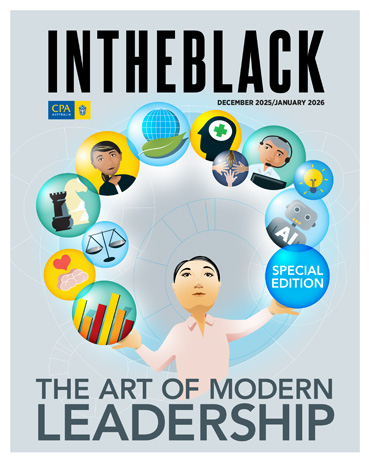Loading component...
At a glance
- Increased demand for services across the not-for-profit sector is not currently being met with more funding or resources.
- Inflation, rising interest rates and the high cost of living have seen more demand for charitable services while also restricting public donations.
- Diversification and investment in technology are helping the sector rise to the challenges it is facing.
Meriem Idris CPA knows how to do more with less. As CFO of GenWest, a not-for-profit organisation delivering services to redress gender inequity and help victim-survivors of family violence in Melbourne’s west, she is adept at making every dollar stretch.
In the 2022-23 financial year, GenWest distributed A$3.4 million in flexible support packages as part of its family violence service to help cover the costs associated with relocation, schooling, household appliances and clothing.
However Idris sees further challenges on the horizon, with government funding becoming increasingly competitive, especially for small to medium organisations that rely on grants to help cover their operational costs and implement programs.
“Funding comes with performance measures that we have to meet,” says Idris, who has worked for the organisation since 2010. “However, it does not address other administrative expenses like finance, HR, IT, quality improvement, risk management and compliance.
“We are just stretching all the time and trying to construct our resources as best we can to achieve our goals.”
Not-for-profits make a huge contribution to the social fabric, economy and Meriem Idris CPA knows how to do more with less. As CFO of GenWest, a not-for-profit organisation delivering services to redress gender inequity and help victim-survivors of family violence in Melbourne’s west, she is adept at making every dollar stretch.
In the 2022-23 financial year, GenWest distributed A$3.4 million in flexible support packages as part of its family violence service to help cover the costs associated with relocation, schooling, household appliances and clothing.
But Idris sees further challenges on the horizon, with government funding becoming increasingly competitive, especially for small-to-medium organisations that rely on grants to help cover their operational costs and implement programs.
“Funding comes with performance measures that we have to meet,” says Idris, who has worked for the organisation since 2010. “However, it does not address other administrative expenses like finance, HR, IT, quality improvement, risk management and compliance.
“We are just stretching all the time and trying to construct our resources as best we can to achieve our goals.”
Not-for-profits make a huge contribution to the social fabric, economy and employment of countries across the globe, but the sector is facing significant challenges that have increased since the pandemic.
The inflationary environment, rising interest rates and the high cost of living have seen more demand for not-for-profit services while also restricting public donations and intensifying the competition for government funding.
The 10th edition of the Australian Charities Report from the Australian Charities and Not-for-profits Commission (ACNC) shows total sector revenue rose by 5.6 per cent, or A$11 billion, to a record high of just over A$200 billion in the 2022 reporting period, compared to the previous period. However, this growth was outstripped by an increase in expenses of A$22 billion in the same period.
In other jurisdictions such as Hong Kong, the sector is experiencing staffing and fundraising challenges in the post-pandemic era, according to a recent survey by the Hong Kong Council of Social Service.
Meanwhile, in Singapore, the National Giving Study 2023 by the National Volunteer and Philanthropy Centre, shows a decline in charitable donations across the city-state.
NFP Audit Requirements course
Pinch points

The NFP sector is characterised by its diversity. There’s a huge variation in the services they provide – from social welfare to environmental, law reform advocacy to sporting groups and faith-based organisations. Challenges also vary across large global organisations that may employ thousands of people, and small entities that may rely solely on volunteers.
In Australia, for example, data from ACNC shows large charities with annual revenue of A$11 million comprise about half a per cent of the sector, but represent 54 per cent of its aggregate revenue.
Very small charities, which have an annual revenue of less than A$25,000, make up a third of the sector, but operate with 0.1 per cent of the sector's revenue.
Sue Woodward AM, commissioner of the ACNC, says that while the sector is not homogenous, it is experiencing “common pinch points” across the board.
“In the commercial business world, when you have an increase in demand, you can put up your prices,” she says. “It doesn't work that way in the NFP sector.”
ACNC data shows charities employ about 10.5 per cent of the Australian workforce, but Woodward notes the sector is experiencing significant staffing challenges. Staffing costs in 2022 increased by almost 10 per cent year-on-year – the highest annual percentage increase recorded.
“Traditionally, where the sector has not offered the highest salaries, it was often a leader in offering flexibility or part-time employment,” says Woodward. “But since the pandemic, more organisations are providing hybrid working arrangements and greater flexibility, so it has become harder for the sector to recruit unless they can go closer to meeting the salaries [in the for-profit sector].”

Ellie Paterson CPA, consulting CFO at Not for Profit Accounting Specialists (NFPAS), a South Australian accounting practice specialising in NFPs and charities, says many of her clients “can see their margins shrinking almost before their eyes”.
“It just gets tougher and tougher,” says Paterson, who previously worked as finance manager for Variety – the Children’s Charity.
“Wage increases are well-deserved, but they make it harder for the NFPs to operate. Payroll costs are a significant proportion of their costs, and a 3.75 per cent wage increase really hurts.”
Nunzio Giunta FCPA, managing partner at Giuntabell in Victoria, an accounting practice that specialises in NFPs and charities, says many entities in the sector consist of directors or executives who are passionate about their cause, but often lack the skills or experience required to run a business.
“As a result, from a governance perspective, they risk getting themselves into trouble,” he says. “We've walked into organisations who have a lot of money owing to the ATO because their superannuation hasn't been paid for years.
“We help a lot of these organisations develop strong governance and make sure they're compliant, because otherwise a lot of these passionate people will be forced to walk away from the industry.”
Seeking new NFP income streams
Even charities that depend mostly on philanthropic revenue may still be feeling the squeeze, with philanthropy likely among the expenses people are cutting under cost-of-living pressures.
Andri Yusetia FCPA is CFO of United In Diversity (UID), an Indonesian not-for-profit organisation with a mission to serve as an educational platform and act as a catalyst for building trust and cooperation among business, the public sector and civil society for a sustainable future.
UID has galvanised leaders from all sectors to collaborate and address challenges across the nation, using Theory U as the social methodology and the United Nations’ Sustainable Development Goals (SDGs) as a framework. Its sponsors include The David and Lucile Packard Foundation, The World Bank and The United Nations Development Program, plus a range of corporate partners.
"In the commercial business world, when you have an increase in demand, you can put up your prices. It doesn't work that way in the NFP sector."
“We have yielded tangible changes in policy reform, governance, social innovation and inclusion of marginalised groups, as well as gender equality,” Yusetia says.
This strengthens the local grassroots economy and drives business-sector transformation “as a key engine of sustainable development”.
Yusetia says UID’s funding model requires the organisations to be “strategic in how we try to attract philanthropic funding and secure funding for the long term as well”.
“That's one of the reasons we focus on the SDGs,” he says.
Diversification is also on the agenda at GenWest. As demand for services increases, Idris says the organisation is seeking new funding streams.
CPA Week
Rising to the NFP challenge
Diversification is just one way NFPs are rising to the challenge.
Giunta is seeing growth in digital transformation projects to increase efficiencies.
“Many organisations are looking at the corporate services arm of their business and saying, ‘How can we support service delivery with artificial intelligence (AI), automation, machine learning and driving good decisions with the data we have, so that we’re not just adding more staff?’”
GenWest integrated its finance systems just before the pandemic and Idris explains it now operates in the cloud.
“We also have an HR and payroll system that integrates with our finance system so, with the limited funds we have, we’re making sure we get better technology so our staff can spend more time on their value-added work.
"Wage increases are well-deserved, but they make it harder for the NFPs to operate. Payroll costs are a significant proportion of their costs, and a 3.75 per cent wage increase really hurts."
“Technology does come with a growing risk of cyber security,” adds Idris. “So this is something that we are focusing on.”
Governments are also stepping up measures to support the sector. In Australia, the federal government has set a goal of doubling charitable giving by the end of the decade. In Singapore, recent government initiatives include new schemes to encourage deeper partnerships between charities and businesses on volunteering, as well as tax relief and government matching on charitable donations.
Paterson says that, in broad terms, her clients in the NFP sector are “very determined, very resilient, very tenacious”.
“The fact that I keep seeing people starting new charities, wanting to make a difference, wanting to find a cure for a terrible disease, wanting to find a new way to combat mental illness or to make a difference to people who have no home – that determination is growing.
“They are getting more creative and productive with technology, and they are diversifying their investment strategies, looking short-term and long-term, and thinking about how their legacy can continue for decades to come.”
Charity versus not-for-profit - what's the difference?

In Australia, a not-for-profit is an organisation that engages in work to benefit the public rather than for profit. To be legally recognised as a charity, an organisation must meet a strict set of requirements and be endorsed by both the Australian Charities and Not-for-profits Commission and the Australian Taxation Office.
All registered charities must be NFPs, and they must only have charitable purposes (as deemed by Australian law) for the public benefit, and not be a government entity, an individual or political party.
NFP self-review requirements

Non-charitable NFPs in Australia are now required to submit an annual self-review return to confirm their income tax exempt status.
The first lodgement is required to be made for the 2023–24 income year, and the return became available for lodgement from 1 July 2024. Jennifer Moltisanti, assistant commissioner at the ATO, explains that the reporting requirements were introduced to enhance transparency and integrity in the tax, super and registry system by ensuring that only eligible non-charitable NFPs access the income tax exemption.
Moltisanti explains that there are only two pathways through which a not-for-profit can be income tax exempt.
“The first is that the NFP is a registered charity with the ACNC. And then it needs to be endorsed by the ATO as income tax exempt.
“Pathway two is that a not-for-profit meets the requirements of one of the eight categories in the tax law to self-assess as income tax exempt.
“If an NFP doesn't meet one of these two pathways, it is a taxable NFP.”
NFPs who self-assess as income tax exempt through the second pathway are now required to notify the ATO of their eligibility for an income tax exemption each year by completing the not-for-profit self-review return.
“That's the only thing that's changed,” says Moltisanti, adding that the self-review return should take about 10 minutes to complete.
“NFPs don’t need to prepare any financials for the self-review return, and it's a great opportunity for all NFPs to do a bit of a hygiene check.
“Check your governing documents, check that your activities are aligned to your purpose, make sure all your details are up to date and when that is all done, it's simple to lodge the NFP self-review return.”
In November 2024, a report was released by The Senate Economics Reference Committee to review the self-assessment requirement for non-charitable not-for-profit entities.
The report made a number of recommendations to provide better certainty and enhance the administration process for affected entities.

